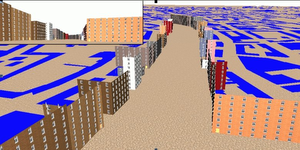Information
- Publication Type: Conference Paper
- Workgroup(s)/Project(s):
- Date: June 2000
- ISBN: 3-211-83535-0
- Publisher: Springer-Verlag Wien New York
- Organization: Eurographics
- Location: held in Brno, Czech Republic, June 26-28, 2000
- Lecturer:
- Editor: Bernard Péroche and Holly Rushmeier
- Booktitle: Rendering Techniques 2000 (Proceedings Eurographics Workshop on Rendering)
- Pages: 71 – 82
- Keywords: Visibility determination, image-based rendering., occluder occlusion, occluder fusion, urban environments, walkthrough, real-time graphics, shadow algorithms, occlusion culling
Abstract
This paper presents an efficient algorithm for occlusion culling of urban environments. It is conservative and accurate in finding all significant occlusion. It discretizes the scene into view cells, for which cell-to-object visibility is precomputed, making on-line overhead negligible. Unlike other precomputation methods for view cells, it is able to conservatively compute all forms of occluder interaction for an arbitrary number of occluders. To speed up preprocessing, standard graphics hardware is exploited and occluder occlusion is considered. A walkthrough application running an 8 million polygon model of the city of Vienna on consumer-level hardware illustrates our results.Additional Files and Images
Weblinks
No further information available.BibTeX
@inproceedings{wonka-2000-VisP,
title = "Visibility Preprocessing with Occluder Fusion for Urban
Walkthroughs",
author = "Peter Wonka and Michael Wimmer and Dieter Schmalstieg",
year = "2000",
abstract = "This paper presents an efficient algorithm for occlusion
culling of urban environments. It is conservative and
accurate in finding all significant occlusion. It
discretizes the scene into view cells, for which
cell-to-object visibility is precomputed, making on-line
overhead negligible. Unlike other precomputation methods for
view cells, it is able to conservatively compute all forms
of occluder interaction for an arbitrary number of
occluders. To speed up preprocessing, standard graphics
hardware is exploited and occluder occlusion is considered.
A walkthrough application running an 8 million polygon model
of the city of Vienna on consumer-level hardware illustrates
our results.",
month = jun,
isbn = "3-211-83535-0",
publisher = "Springer-Verlag Wien New York",
organization = "Eurographics",
location = "held in Brno, Czech Republic, June 26-28, 2000",
editor = "Bernard P\'{e}roche and Holly Rushmeier",
booktitle = "Rendering Techniques 2000 (Proceedings Eurographics Workshop
on Rendering)",
pages = "71--82",
keywords = "Visibility determination, image-based rendering., occluder
occlusion, occluder fusion, urban environments, walkthrough,
real-time graphics, shadow algorithms, occlusion culling",
URL = "https://www.cg.tuwien.ac.at/research/publications/2000/wonka-2000-VisP/",
}


 Paper
Paper
